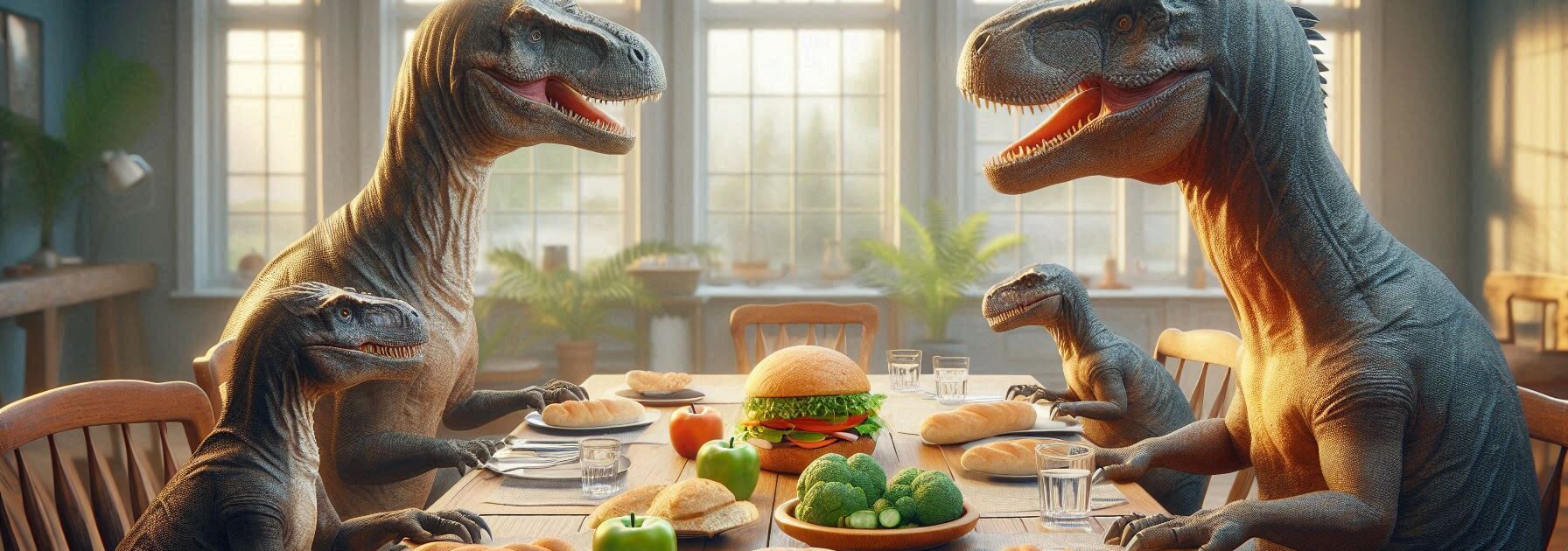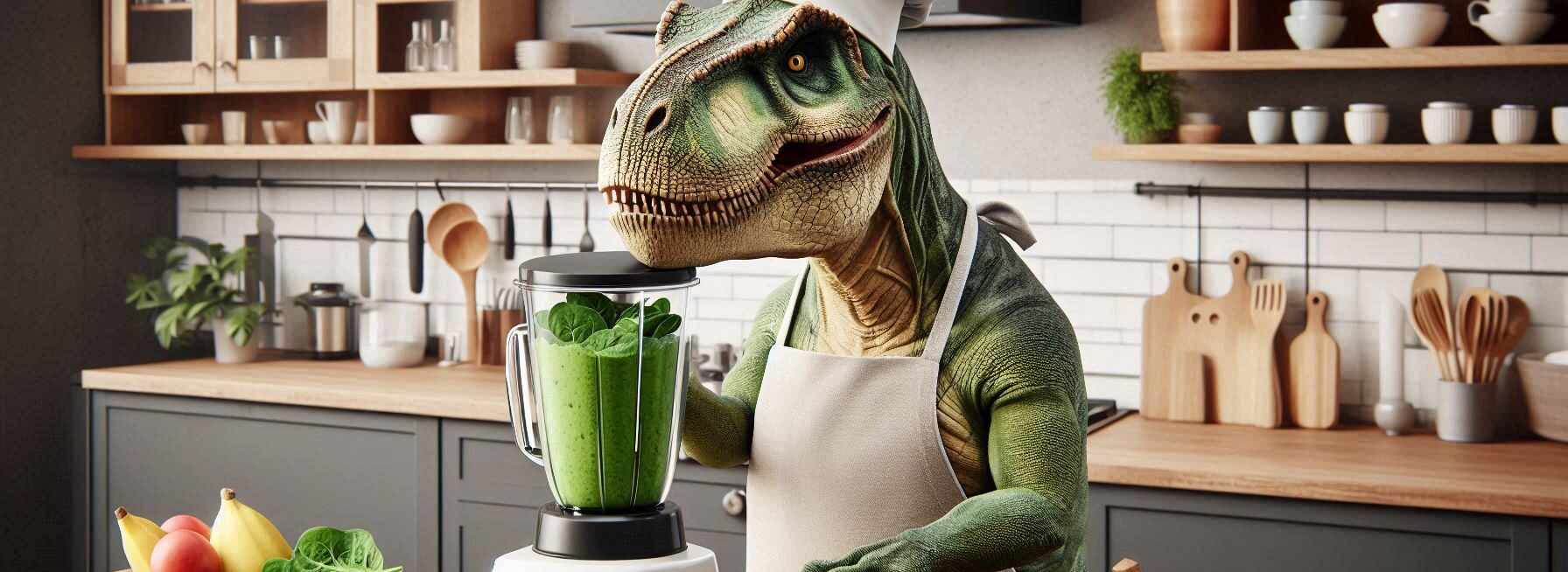Please Note: This post may contain affiliate links. If you click one of them, we may receive a commission at no extra cost to you. As an Amazon Associate, I earn from qualifying purchases.
When I think of the mighty Stegosaurus, I picture a creature that thrived on a diet of plants, munching its way through lush foliage.
Now, while we humans don’t have the luxury of roaming vast prehistoric landscapes in search of our next meal, we can certainly learn a thing or two from these gentle giants about managing portion sizes.
Top Takeaways and Key Concepts
- Fill half your plate with vegetables to naturally control portion sizes.
- Use fist-sized portions for protein and smaller servings for carbohydrates.
- Present meals creatively with colorful ingredients to encourage healthier eating.
- Practice mindful eating by slowing down and savoring each bite.
- Prepare healthy snacks in advance and maintain consistency in habits.
Article Summary
This text uses the Stegosaurus as a metaphor to teach practical strategies for portion control and healthy eating. Key advice includes filling half your plate with vegetables, using appropriate protein and carbohydrate portions, and making meals visually appealing to encourage satisfaction. Mindful eating is emphasized, encouraging slower, more attentive consumption to improve digestion and enjoyment. Planning healthy snacks ahead of time helps avoid mindless indulgence, while consistency in practicing these habits ensures long-term success. Overall, the article focuses on sustainable, incremental changes rather than drastic dietary overhauls.
Video Summary
So let’s dive into some practical steps for dieting like a Stegosaurus and keeping those portions in check!
Understanding Portion Sizes: The Basics

First things first: what exactly is a portion size? It’s not just about how much food you pile onto your plate; it’s also about understanding what your body really needs.
Think of it this way—if our friend the Stegosaurus could eat only so many leaves at once, why should we be any different with our meals?
By the way, when I first started learning about portion sizes, it felt like trying to decipher an ancient dinosaur language!
But here’s the good news: there are simple guidelines to follow. For instance, filling half your plate with vegetables is a great start. This isn’t just healthy; it also helps keep your portions balanced.
Let’s see if we can break down some common serving sizes. A fist-sized portion of protein (like chicken or tofu) is generally adequate for most meals.
And remember that carbs—while delicious—should take up less space than veggies and protein combined! It sounds straightforward enough, right?
Plate Presentation: Making Meals Appealing
Now that we’ve got our portion sizes sorted out, let’s talk about presentation! You know how appealing a well-arranged plate looks?
It makes you want to dig in immediately! When you prepare meals like a Stegosaurus would forage for food, consider using colorful ingredients and varying textures.
Speaking of which, try arranging your plates like they’re ready for an art exhibit. Use vibrant greens alongside bright reds and yellows; think bell peppers mingling with leafy spinach!
Not only does this make your meal visually stunning but it also encourages healthier choices.
Interestingly enough, studies show that people tend to eat less when their food is beautifully presented versus thrown together haphazardly on the plate. So get creative! Serve smaller portions on larger plates to trick your brain into feeling satisfied without overindulging.
Mindful Eating: Savoring Every Bite
Here comes my favorite part: mindful eating! Imagine if our friend the Stegosaurus took time to savor each leaf rather than chomping away mindlessly. We can adopt this approach too by slowing down during meals and truly enjoying what’s on our plates.
Honestly, have you ever noticed how fast-paced life can be? Between work deadlines and social commitments, it’s easy to rush through meals without even tasting them!
To combat this habit, try putting down your fork between bites or engaging in conversation with others at the table. It gives you time to appreciate flavors while allowing digestion to catch up.
All things considered, creating an atmosphere conducive to mindful eating is essential too. Dim lights? Check! Soft music playing in the background? Absolutely!
This environment will help transform mealtime into something special instead of just another task on your busy schedule.
Snack Smart: Choosing Healthy Options
Now let’s tackle snacking—the sneaky culprit behind many unintentional extra calories! Just as dinosaurs had specific diets based on their environments (thank goodness they didn’t have access to vending machines), we need to choose snacks wisely.
To be fair, snacking isn’t inherently bad; it all depends on what you’re choosing! Instead of reaching for chips or sugary treats every afternoon slump hits hard (and believe me—it happens), opt for healthier options like fruits or nuts instead. These foods provide energy while keeping portions reasonable!
I think preparing snacks ahead of time is key here too. Chop up carrots and cucumbers for easy munching later or create snack bags filled with trail mix made from nuts and dried fruits—perfect fuel before heading out for errands!
Staying Consistent: Building Healthy Habits
Finally—and perhaps most importantly—is consistency in maintaining these habits over time. Just as dinosaurs evolved over millions of years adapting their diets accordingly—so must we adapt ours gradually until healthy eating becomes second nature!
Set small goals each week focused specifically around portion control rather than drastic changes overnight (because who wants that?). Maybe aim for one vegetable-packed dinner per week initially before expanding further as comfort grows!
On the other hand… don’t forget about celebrating victories along this journey too! Did you manage not to go back for seconds at dinner last night? Give yourself credit where it's due because every step counts toward achieving lasting change!
Suggested External Resources:
Healthy Eating Plate
https://www.hsph.harvard.edu/nutritionsource/healthy-eating-plate/
Portion Control Tips
https://www.eatright.org/health/weight-loss/your-health-and-your-weight/portion-control-tips-for-weight-loss
Mindful Eating Practices
https://www.eatmindfully.com/
Frequently Asked Questions
How can filling half my plate with vegetables help with portion control?
Vegetables are low in calories and high in volume, so filling half your plate with them helps you feel satisfied without overeating.
What is a good visual guide for protein portions?
A fist-sized portion works as a simple rule of thumb to provide enough protein without excessive calories.
Why does plate presentation affect how much I eat?
Colorful, visually appealing meals encourage healthier choices and may help you feel satisfied with smaller portions.
How does mindful eating improve portion control?
Slowing down and savoring each bite gives your body time to register fullness signals, helping prevent overeating.
Are snacks allowed when practicing portion control?
Yes, as long as snacks are planned and nutritious, such as fruits or nuts, rather than processed high calorie options.
Should I prepare snacks ahead of time?
Preparing snacks in advance makes healthier options easier to choose and reduces impulse eating.
Why is consistency important in portion management?
Small steps practiced regularly turn into long term habits that make healthier portion control feel natural and effortless.

Kevin Collier is a passionate nutritionist and wellness advocate dedicated to helping individuals achieve their health goals through balanced eating and sustainable lifestyle choices. With years of experience in the field, Kevin believes in the power of nutritious food to transform lives and specializes in creating articles about diet plans and achieving weight loss goals. When not writing for DietDino, Kevin enjoys exploring new recipes, staying active outdoors, and sharing tips on mindful living.




